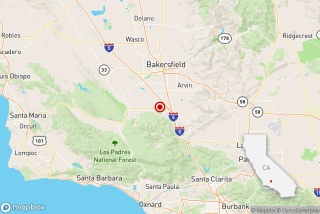Founding Fathers : In 1776, History Was Being Made Here, Too
- Share via
July is a time to remember how the Founding Fathers gathered in Philadelphia in 1776 to sign the Declaration of Independence. But what was going on in Southern California? From an East Coast perspective, not much. Still, the 1770s were an important decade in the history of the region, a time when Spanish explorers made some of their first expeditions in what eventually became Los Angeles.
Progress was gradual. Los Angeles wasn’t founded until 1781, the same year the 13 former colonies adopted the Articles of Confederation as their first constitution. The San Fernando Mission wasn’t founded until 1797, nine years after the Articles were scrapped and replaced with the Constitution.
But even in the 1770s, the San Fernando Valley’s potential was apparent. Diarist Juan Crespi, part of the first Spanish expedition in the Valley, described it as “vastly lush.” “All very good, very grassy soil, though most of it had been burnt off; many patches however had not been, where grass still showed.”
The Spanish gave the Valley two names: Santa Catalina de Bononia (St. Catherine of Bologna) and Los Encinos (the oaks.) Crespi estimated the Valley to be “over two leagues in breadth, north to south; its length, east to west, may perhaps be six or seven leagues”--basically from Mission Hills to Sherman Oaks and from Burbank to Canoga Park. It would be, he predicted, a good location for a town.
THE WORLD IN 1776
The future Queen Louise of Prussia is born.
Potemkin, a favorite of Czarina Catherine II, organizes the Russian Black Sea Fleet.
Edward Gibbon’s “The Decline and Fall of the Roman Empire” is published.
Mozart’s Symphony No. 35 in D Major (Haffner) is published.
Capt. James Cook makes his third voyage in the Pacific.
A TIME OF DISCOVERY
While a new country was being formed on the East Coast, the San Fernando Valley was being explored by the Spanish. Some key events in early Valley exploration:
July 14, 1769: The Portola Expedition leaves San Diego for Monterey, two days before the founding of the mission of San Diego de Alcala.
Aug. 5, 1769: Juan Crespi and his group descend upon the San Fernando Valley via what is now Sepulveda Boulevard. The expedition continues north through the Valley to the Santa Clara River, making its way through Ventura County on the way to Northern California.
Jan. 15, 1770: The expedition returns to the Valley, having traveled from Ventura by way of Calabasas. They stop by a large pool of warm water at what is now Los Encinos State Historical Park, then travel through the Cahuenga Pass into what is now Hollywood.
Sept. 8, 1771: San Gabriel Mission is founded.
February, 1776: Another expedition, lead by Juan Bautista de Anza, passes through the Las Virgenes area.
July 4, 1776: Declaration of Independence is adopted in Philadelphia.
Sept. 4, 1781: Los Angeles is founded.
Sept. 8, 1797: San Fernando Mission is founded.
NATIVE POPULATION
When the Spanish arrived in the 1700s, they encountered American Indians who gave the missionaries acorns and berries. Between 3,500 and 5,000 Indians lived in the Valley at the time, many of them making their home in what is now Encino. These Indians, later named the Fernandeno, helped build the San Fernando Mission. A separate and larger group, the Chumash, lived in Malibu, Agoura, Westlake Village and in Ventura County.
PAST AND PRESENT
Southern California was a different world in 1776--literally.
Existing in California pre-Spanish:
Oak trees
Grapes
Walnuts
Prickly pears
Grizzly bears
*
Brought here by the Spanish:
Barley
Oats
Wheat
Oranges
Horses
Sources: “Oh, California,” “Mission San Gabriel Arcangel 1771-1971,” “The Timetables of History,” Encyclopedia Britannica and translation of Crespi’s diary by Alan K. Brown of Ohio State University.
More to Read
Sign up for Essential California
The most important California stories and recommendations in your inbox every morning.
You may occasionally receive promotional content from the Los Angeles Times.













